Road Safety in Scotland and Beyond
Scotland's Road Safety Framework to 2030
Road Safety in Scotland and Beyond
Scotland's Roads are safer than they were in 2010
Scotland has a long-standing commitment to road safety delivery based on strong partnership working. This has led to a consistent reduction in casualties. Provisional headline figures for road casualties reported to the police in Scotland in 2019[6] show the total number of casualties fell to 7,594, the lowest number since annual records began in 1950. However, there has been an increase in the number of people who have died on our roads in 2019[7]. This fact provides no comfort to the friends and family of those who have sadly lost their lives and proves that Scotland needs to do more work. Scotland's overall road death rate of 29 per million population was the fifth lowest of 42countries surveyed in international comparisons in 2018. Our aim is for it to be the lowest.
Progress towards the 2020 Casualty Reduction Targets
The current Framework to 2020 contains five challenging targets that all road safety partners are responsible for delivering, including the Scottish Government.
With Vision Zero in mind, achieving the targets is crucial to a Scotland which aspires to have the best road safety performance in the world. Not only is there a moral imperative to prevent casualties on our roads, given the pain, loss and suffering experienced by immediate families and the ripple effect on the wider communities, but road casualties also has a high economic cost including: damage to vehicles and property; loss of output/productivity[8]; demands on the emergency services; as well as ongoing medical and insurance costs.
Currently available data allows us to measure progress against three targets; progress against all targets will be published in October 2020 (see Table 2 and Figures 3 to 7 below).
- 168 people were killed in 2019, a reduction of 42% since the baseline (performance currently exceeding the 2020 target of a 40% reduction).
- 2,001 people were seriously injured in 2019. Due to the changes in the recording of casualty severities, following Police Scotland's use from around June/July 2019 of a new accident and casualty data recording system called CRaSH (Collision Reporting and Sharing), progress against this target is measured on the basis of adjusted figures, which show a reduction of 33% from the baseline (performance not currently on track to meet the 2020 target of a 55% reduction).
- On average, there were two children killed each year between 2017 and 2019: a reduction of 85% from the baseline (performance currently exceeding the 2020 target of a 50% reduction).
| 2020 Target (adjusted* 2004-08 baseline) | Progress towards targets in 2019** |
|---|---|
| 175 = 40% reduction in people killed (292) | 168 = 42% reduction |
| 1,313 adjusted = 55% reduction in people seriously injured (2,919 adjusted baseline) | 2,001 (non-adjusted figure) 1,965 adjusted = 33% reduction |
| 8 = 50% reduction in children killed (15) | 2 = 85% reduction |
| 114 (still needs to be adjusted) = 65% reduction in children seriously injured (325 - still needs to be adjusted) | % reduction based on adjusted figure for 2019 will be available end of September but 56% reduction was reported in 2018 |
| 29.22 (still needs to be adjusted) = 10% reduction in the slight casualty rate (32.47 casualties per 100 million vehicle kilometres - (still needs to be adjusted) | % reduction based on adjusted figure for 2019 will be available end of September but 57% reduction was reported in 2018 |
*adjusted figures if they had been recorded using the injury-based reporting system CRaSH
**provisional statistics from Key Reported Road Casualties Scotland 2019
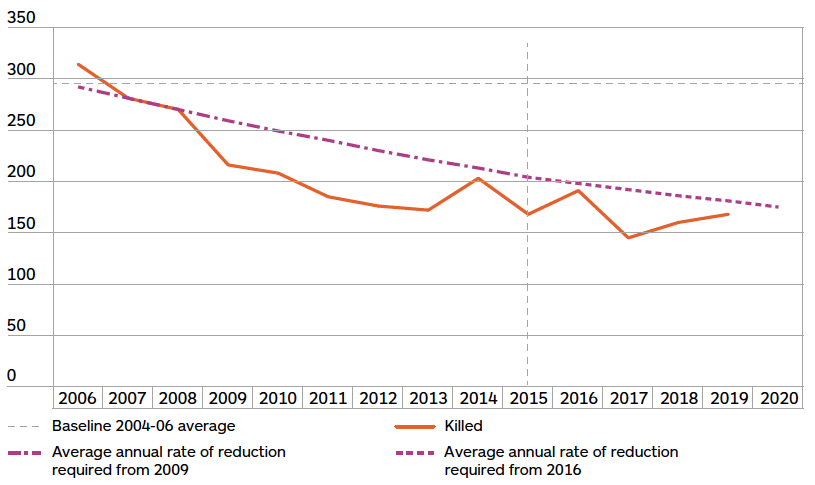
*Due to changes in the way casualty severities are recorded, figures for serious casualties in 2019 are not comparable with previous years.
Figure 4: Progress to casualty reduction target: Seriously-injured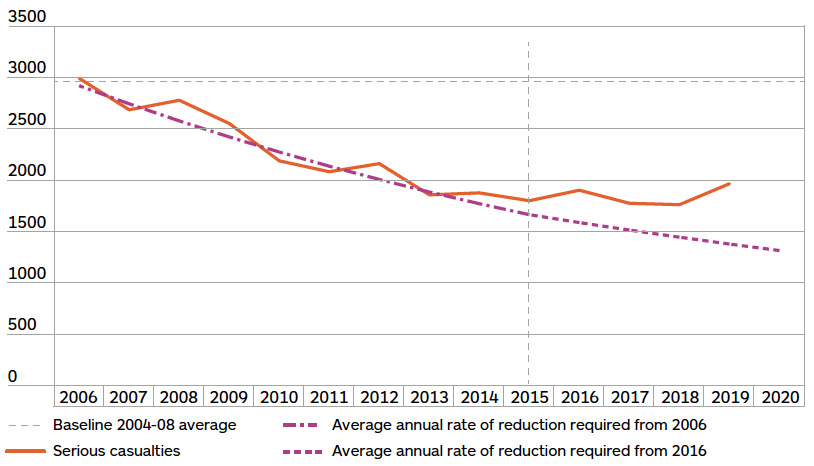
*Due to changes in the way casualty severities are recorded, figures for serious casualties in 2019 are not comparable with previous years.
Figure 5: Progress to casualty reduction target: Children killed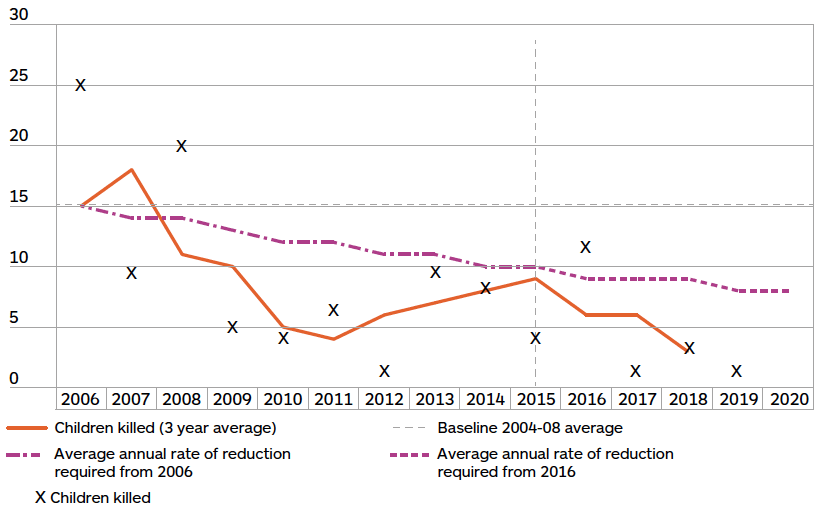
*Due to changes in the way casualty severities are recorded, figures for serious casualties in 2019 are not comparable with previous years.
Figure 6: Progress to casualty reduction target: Children seriously-injured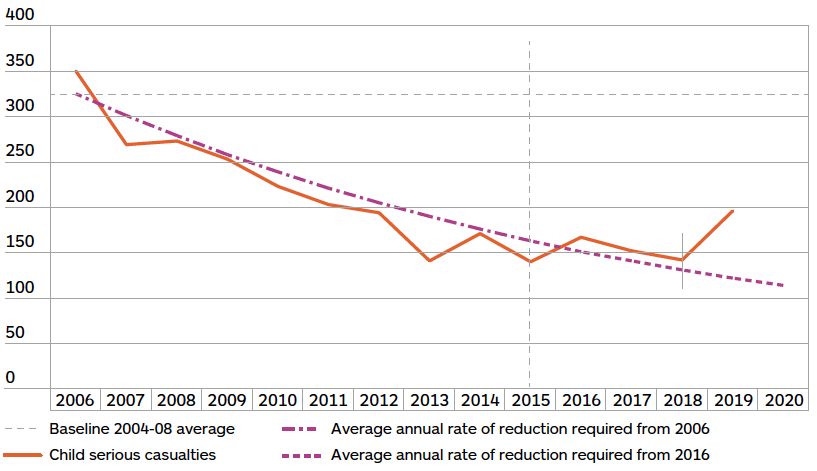
*Due to changes in the way casualty severities are recorded, figures for serious casualties in 2019 are not comparable with previous years.
Figure 7: Progress to casualty reduction target: Slightly Injured casualties per 100 million vehicle km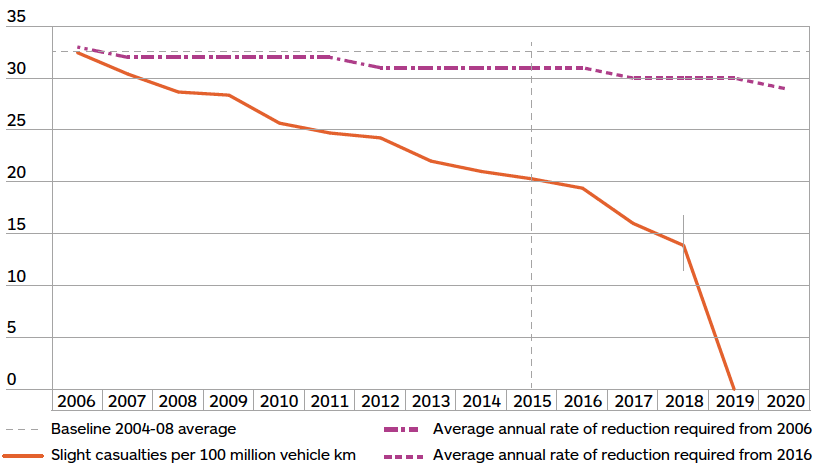
*Due to changes in the way casualty severities are recorded, figures for serious casualties in 2019 are not comparable with previous years.
The 2020 Framework: highlights from the last decade
The Framework to 2020 has been running for almost a decade now and its success has been quantified by progress towards the current targets, as well as the completion of almost all 97commitments (96 original + 1 added in the Midterm Review) which remained relevant throughout the period. The adoption of the Safe System and identification of three Priority Focus Areas of Age, Speed and Vulnerable Road Users in the 2016 Mid-term Review allowed us to concentrate our effort on areas where maximum impact could be achieved towards delivering the 2020 targets. This effort was supported by stronger partnership working, evidence-led decision-making and finance provided through the Framework Fund and the more-recent Evaluation Fund. These measures contributed to Scotland's roads being safer than in 2010, and created better conditions for delivery of the Healthy and Active Nation agenda.
The Broader Picture: the UN, WHO, the EU and the UK
The Global status report on road safety 2018[9], launched by the World Health Organisation in December of that year, highlights that the number of global road traffic deaths continues to climb, reaching 1.35 million in 2016. However, the rates of death relative to the size of the world's population has stabilized in recent years. At this rate, the Sustainable Development Goal (Target 3.6) to halve road traffic deaths by 2020, will not be met. Road traffic injuries are now the leading killer of people aged 5-29 years, signalling a need for a shift in the current child health agenda, which has largely neglected road safety. Road collisions are the eighth leading cause of death for all age groups, surpassing HIV/AIDS, tuberculosis, and diarrhoeal diseases. The burden is disproportionately borne by those classed as vulnerable road users - pedestrians, cyclists and motorcyclists - particularly in developing countries.
In February 2020, the third global ministerial conference in Stockholm reviewed the UN decade of action on road safety, adopted the Stockholm Declaration[10] and set goals for 2030. This was followed by a general assembly and the adoption of a new resolution on road safety.[11]
Closer to home, fewer people lost their lives on EU roads in 2019, according to preliminary figures [12] published in June 2020 by the European Commission. An estimated 22,800 people died in a road crash last year, almost 7,000 fewer fatalities than in 2010 a decrease of 23%. Compared with 2018, the number fell by 2%. With an average of 51 road deaths per 1 million inhabitants (compared to 200 in 1965), Europe remains by far the safest region in the world when it comes to road safety.
A plateauing of the reduction in fatalities has been occurring since 2013 which means it is unlikely that the target of halving the number of road deaths by 2020 will be reached, even when factoring the initial positive effect of Covid-19 lockdowns[13] on traffic flows reductions and reduced road fatalities (see Figure 8[14] below).
Figure 8: Reduction in the % number of road deaths since 2010 for the EU28 taken together (blue line) plotted against the EU target for 2020 (blue dotted line).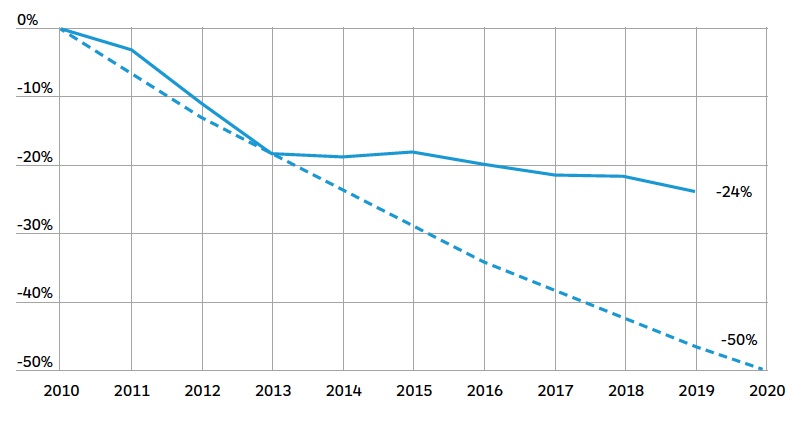
In June 2019, the European Commission published its Staff Working Document: EU Road Safety Policy Framework 2021-2030 - Next steps towards "Vision Zero"[16]. This maps out the way forward, implementing the Safe System approach systematically at EU level and encouraging members to follow the Safe System results' hierarchy below (Figure 9).
Great Britain is seeing a similar plateauing with 1,870 road deaths in the year ending June 2019[17] which is an increase compared to the previous year. This change is not statistically significant and long-term trends are broadly stable since 2010. Over the same period, the volume of traffic on roads in Great Britain has increased by 7%. In July 2019, the UK Government published its refreshed Road Safety Statement and two year action plan[18] acknowledging that flat lined trend. The Statement recognises we can no longer keep doing the same things in the same way if we want to improve. It puts forward 74 actions covering road safety policy in Britain, moving the UK towards an integrated approach that focusses on both collision prevention, and post-collision response.
The Statement is based on a lifelong-learning approach to road safety, from the very young to the elderly.
Figure 9: The EU Safe System results hierarchy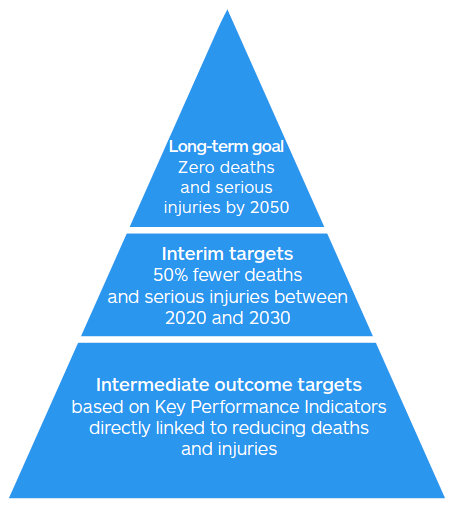
Summary
Many of the road safety issues in the last decade at UN/EU or UK level have also been experienced in Scotland; there has been a substantial reduction in killed and seriously-injured casualties (KSIs) since the 1970s, but the recent plateauing of these reductions means road safety needs to be back at the top of the agenda. Most developed countries recognise that, to achieve further reductions in KSIs, a step change in road safety delivery is required: from providing focus for improved joint working, to embedding the Safe System ambition and approach into the delivery of national and local activity.